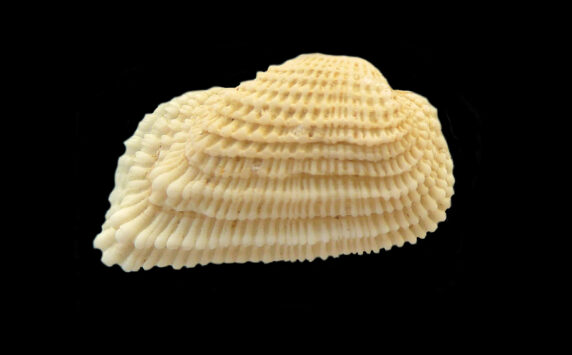 The Ribbed Ark, Arca gradata, a representative Bivalve or Pelecypod from the Ark Shell or Arcidae Family.
The Ribbed Ark, Arca gradata, a representative Bivalve or Pelecypod from the Ark Shell or Arcidae Family.
Bivalve, which also known has Bivalvia, Lamellibranchiata and Pelecypoda, is a class of marine and freshwater mollusks that have laterally compressed bodies enclosed by a shell consisting of two hinged parts. The bivalves do not have heads and lack organs, like the radula and the odontophore They include the clams, cockles, oysters, mussels, scallops and and numerous other families found in saltwater, as well as a number of families that live in freshwater. The majority are filter feeders. Their gills have evolved into ctenidia, which are specialized organs for feeding and breathing. Most bivalves bury themselves in sediment to avoid predation. Others lie on the sea floor or attach themselves to rocks or other hard surfaces. Some bivalves, such as file shells and scallops can swim.
The bivalve shells normally have bilateral symmetry, with a hinge lying in the sagittal plane. They vary in size from less than a millimeter to over one meter, but the majority are less than 10 cm (3.9 inches) in length.
Bivalve mollusks have long been a part of the diet of coastal and riparian human populations. Oysters were cultured in ponds by the Romans, and mariculture has more recently become an important source of bivalves for food. Modern knowledge of molluscan reproductive cycles has led to the development of hatcheries and new culture techniques. Pearl Oysters are the most common source of natural pearls. The shells of bivalves are used in craftwork, and for the manufacture of jewelry and buttons. Bivalves have also been used in the biocontrol of pollution.
Bivalves are known from fossils from the early Cambrian Period, more than 500 million years ago. The total number of known living species is 9,200 have been placed within 1,260 genera and 106 families. Of these marine bivalves (including brackish water and estuarine species) represent about 8,000 species, combined in four subclasses and 99 families with 1,100 genera.
This Website, Mexican-shells.org, currently has 85 Bivalves found in Mexican waters. Each individual shell has its own stand-alone page which can be found via the links listed below within the alphabetical indexes presented by Common Name, Genus and Species and Family provided immediately below. For family presentations each shell found in this website has been placed in its specific family, along with its fellow family members, with support information provided for its family as well as a link in the photo caption that will take you to the shell page that has additional photographs and shell specific information.
Bivalve or Pelecypod Shells – Alphabetical Index by Common Name
Bivalve or Pelecypod Shells – Alphabetical Index by Genus and Species